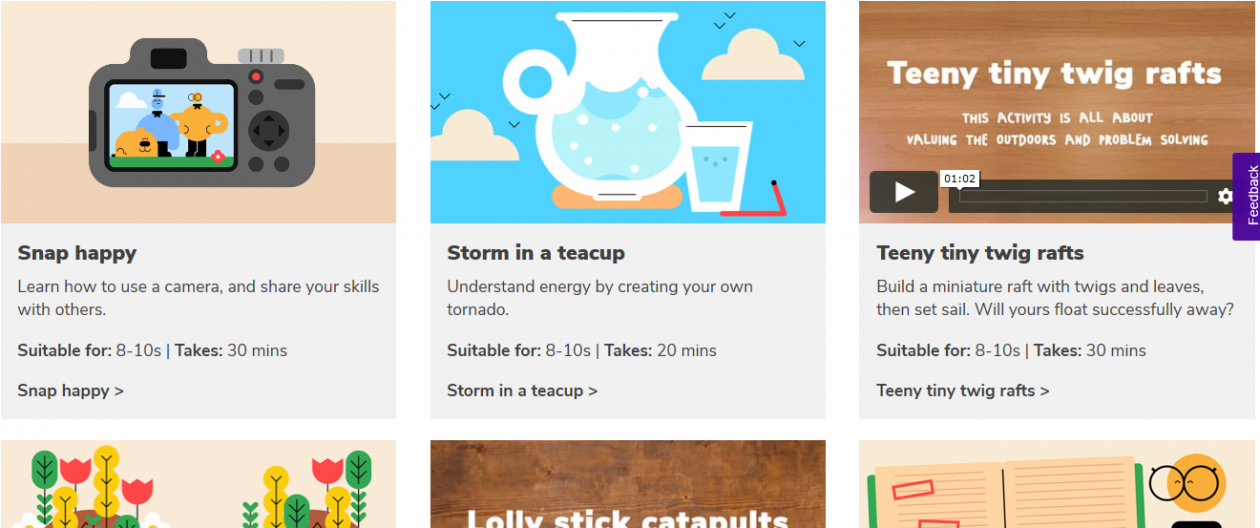The purpose of this page is to provide some information and ideas for parents and carers that might be useful in the coming weeks. Remember that to help your child remain calm, it is important that the adults around them keep calm and try to talk and behave in their usual way.
On this page you will find information about:
1.Talking to your Child about COVID 19
2.Your Child’s Wellbeing
3.Things to do at Home
4.Additional Resources
We will regularly add to these resources so please add the site to favorites so you can visit again. You will also find information on our Children and Young Person’s page for you or your child to access:
1. Talking to your child about COVID-19
There is a great deal of information about the coronavirus being released every day that can make it hard to keep up to date with developments as a parent. Children will be able to access lots of information too through social media and discussions with friends. This can make it difficult for parents and carers to know what our children understand about COVID-19 and to know what to say to them.
What can help?
Talking to your child about the Coronavirus may seem difficult but there are lots of online resources and websites that can help your child understand the facts. We have a few listed for you which you could use here.
Remaining calm when talking about the Coronavirus is important. If we are anxious, our children will notice this and can begin to feel anxious as a result. Remaining calm and confident when discussing the Coronavirus will help them remain calm about it.
To do this it’s important for us as parents and carers to know the facts about Coronavirus. This will ensure we give the right information to our children and we can help them feel safe.
Don’t overload your child with information and try not to be reactive to the changes ahead – it’s natural when things are unpredictable or uncertain to react and do something to try and make our children feel safe. However, these reactions can have the opposite effect. Where possible responsive, not reactive.
More Information to help you talk about COVID-19
The British Psychology Society (BPS) have created a document providing advice and guidance to help you talk to children about Coronavirus:
The Child Mind Institute has a useful page with more advice on talking to your child about the Coronavirus:
Dr Marie J Hill, an educational psychologist, has produced a handy guide on how to talk to your child about the Coronavirus outbreak
Social Stories and Visuals
Please find some additional ways to help your child understand about COVID-19. These may be useful for younger children, children with additional support needs or simply those who prefer things more visual.
Carol Gray has also written a useful document that helps parents to tell their child about the Coronavirus, washing hands and school closures.
For younger children and those who like a visual story, have a look at this lovely story with Nurse Dotty explaining what the Coronavirus is and what you can do about it.
We have lot’s more visual resources below in the 5.Additional Resources section and on our additional support needs page- click here.
2. Your Child’s Wellbeing
As public conversations around the Coronavirus increase, children and young people will have lots of access to information through social media, websites and TV. Some of the images and messages could make them worry about themselves, their families and friends getting ill. Parents, carers, family members and other trusted adults can play an important role in helping children make sense of what they hear in a way that is honest, age appropriate, accurate, and minimizes anxiety or fear.
As mentioned above, remaining calm when talking about the Coronavirus is important. Children will notice changes in the way their parents talk and act or if they are becoming anxious. This can make them think that something is wrong and which could make them worry. Trying to stay as calm, confident and reassuring as possible will help them feel safe.
Due to the exposure and access to a large amount of information online and through social media, children and young people will be reading lots of news stories and seeing lots of potentially worrying images. With schools also closing, they may feel anxious about the seriousness of the current situation and worry about potentially vulnerable family and friends. It is important that we help them to understand that these feelings are normal and an expected response to the situation.
There are lots of websites on our Child and Young Person page on this blog that you can visit or suggest your child visit to help them understand and feel better about the situation, but simply try to:
continue in a normal routine: as much as you can make sure your child has sleep, meals, learning time, fun, and is being active throughout their day at appropriate times. Here’s a video with more information
manage your own anxiety: try and make sure you have some social support to help you continue to model good coping behaviours.
limit time on social media: to make sure they are learning the facts about the Coronavirus and not viewing too much negative content. If you are going through a period of isolation, this could increase the time on social media so it is important this is managed.
staying connected: making sure they are in contact with positive peers as much as possible. Your child would normally be seeing their friends everyday, but this will certainly now reduce and if you are going through a period of isolation they need to stay in contact. It is also important to make sure they can contact people they may be concerned about, e.g. elderly relatives.
feel a sense of achievement in the day: learning something new or doing something new can help them stay positive and active.
give a sense of control: there is so much about the current situation that is out of everyone’s control, it is important to help your child feel a sense of control though choice in activities, routines and responsible tasks. Show them what they can do to protect themselves such as how to wash their hands and what to do if they cough or sneeze.
Help your child to follow some of these steps:
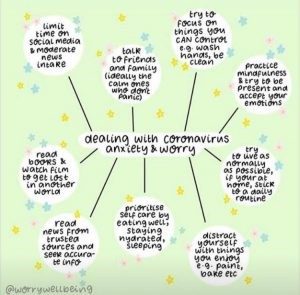
3. Things to do at Home
During times of unplanned school closure both adults, children and young people alike have to adapt to new ways of working and living that may look very different to their usual everyday life. Many young people may think about being at home in terms of what this normally looks like during the holidays, for example, being out with friends or going places. It will take time for young people to adjust to being at home with family and carers for the majority of their time and potentially in social isolation.
Routines
During times of uncertainty, it can be helpful for our wellbeing to have a routine. Our colleagues at Glasgow Psychological Service have shared some useful top tips for setting up a routine at home.
- Set times for getting up and going to bed for your child.
- Have regular times for meals.
- Build in time for fresh air and exercise as far as this is possible.
- Structure your child’s day so that they have a variety of activities and break times.
- Create a menu of activities that your child can do during the day.
- Make a daily plan of activities and share these with your child the night before so that you and your child know what is happening the next day.
- Review the day’s activities and talk about what they have done. A sense of accomplishment is important for children and young people.
- Make Monday to Friday different from the weekend by structuring the activities along the same timings as a normal school day.
- Decide when and for how long your child will have access to electronic devices and for what purpose.
- Maintain contact with friends and family through technology
Below is an example of a daily routine:
Learning at Home
What learning can my child do at home?
What your child can do at home will naturally depend on their age and stage of development. Your child’s school or nursery will give you guidance on work or activities your child could do at home. It will be useful to check the school’s webpage or twitter feed for ongoing advice about activities. Do activities at your own child’s pace. Remember that everyone is in the same situation together and that your child’s school will be ready to support learners when they return.
There are a range of websites that can be helpful to support home learning. Some ideas can be found here (BGE link). Keeping a regular check on what your child is doing when online is vitally important to keep them safe.
Some useful advice for supporting children who are not yet at school can be found here:
With preschools closed, we asked our experts for guidance on how parents can maintain structure, routine, and healthy habits for learning and growing at home. https://t.co/156gKnEPD2
— Harvard Graduate School of Education (HGSE) (@hgse) March 17, 2020
Some children and young people may feel anxious about their school closing. Spending time together as a family where possible and engaging in fun activities can help young people feel secure and relaxed. Feeling safe and calm in important to help us to learn and take on new challenges.
It is important to remember that there are many informal and highly valuable learning activities at home e.g. helping to prepare meals, mending items and playing games together. Activities such as these support young people to use their literacy and numeracy skills in context.
When thinking about how a learning day at home might look is helpful to build in lots of time for breaks and opportunities to connect with others. Here are some examples:

What each family does will be different according to their own circumstances. It can be helpful to share ideas with friends but it is important not to put pressure on yourself to follow the keep up with what others are doing. It is most important to do what suits your child and your family best
Some young people will find it useful to have a visual schedule. This can be particularly helpful for younger children or for those with additional support needs. Here is an example:
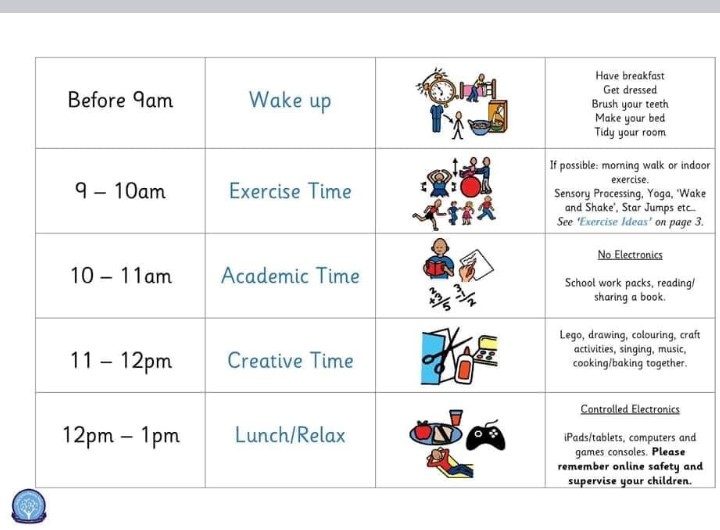
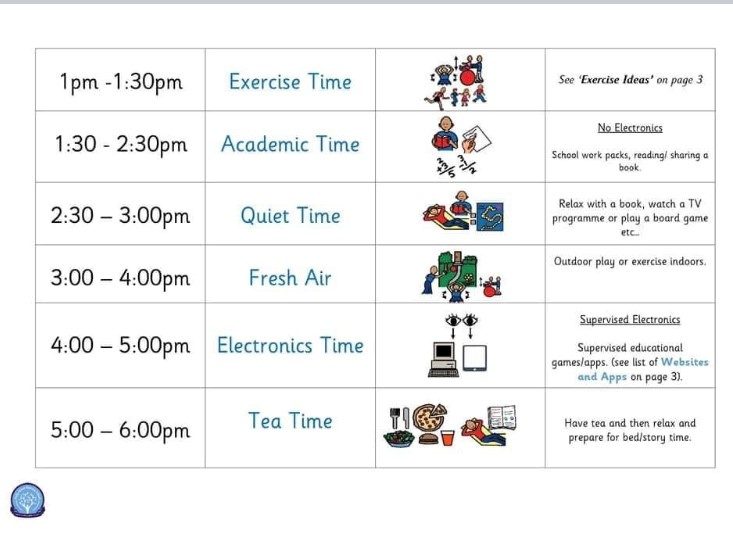
For some children, including those who are younger, it may be best to have simply a picture or a photograph of what you are doing now and what you are going to do next. If your child already uses visuals in school it is a good idea to keep using these. If you don’t have access to a computer or printer, you can use simple line drawings. The School Closure Toolkit has many other ideas to support learners – you can find this below in 5.Additional Resources.
Many young people will be used to using electronic devices and gaming in their free time at home. It can be helpful to be clear about expectations of how much screen time will be available and have some alternative suggestions available:
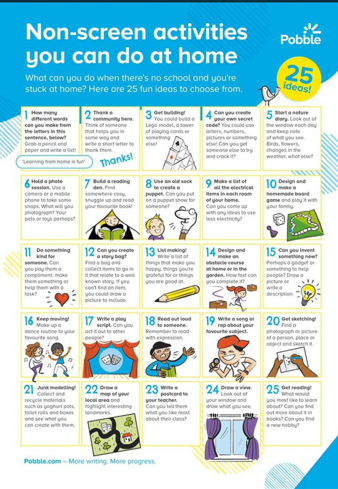
Many young people normally attend clubs and activities which they enjoy, but are unlikely to be running at the moment. Where possible it can be helpful to find opportunities in the daily schedule to engage in these hobbies e.g. practicing a musical instrument or football skills. Many clubs are offering online options whilst classes are off.
The Scouts have added 100+ activities to do indoors on their page The Great Indoors The Great Indoors. Lots of ideas to keep you busy as well as things to do with friends remotely. Take a look at some:
Keeping Active
Beacon House have uploaded a great way to keep children regulated (and entertained!) – get them to do obstacle courses. They can plan their own, write it down, test it, change it, most importantly have fun with it.
Joe Wicks has announced he will start online PE lessons to help keep children fit and healthy during the school shutdown. Find an example and his YouTube channel below:
4. Additional Resources
General Advice
A document has been created by a number of partners including the NHS, YouthLink and YoungScot that has lots of general advice and ideas around the Coronavirus. Click here
UNICEF have set up a page providing parents with all the latest updates and news regarding the Coronavirus. It has some useful articles on how to talk to children about the Coronavirus as well as Q&A videos and tips on how to wash your hands. Click here
Social Stories/Visual Supports
These social stories are a great way to talk to your child about getting ill and the importance of washing your hands. Click each one to open:







